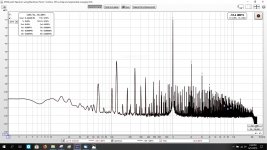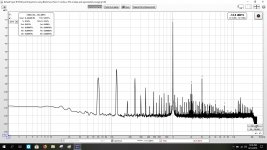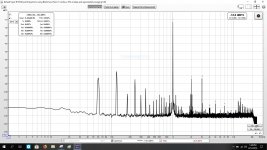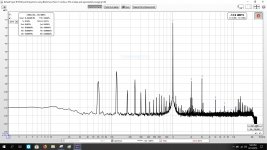@RafaPolit - I can't be completely sure, but I am pretty sure the values measured between the pins on the pot won't be the same with the pot in the circuit (on the board). I should have centered it before installation. I did adjust it until the values read across R1 and R2 read roughly equivalent, but I don't think that is quite as close as it should be. Thanks!
@Itsmee - thank you! That makes sense. Apologies for the additional questions. Is it safe and the right thing to do with a bench supply? ~46VDC between "pin 1 and pin 3" on the IPS? Or, must this be done with the IPS board installed on the amp board and in the amp with power from the actual rails? Just for my own sanity -- Is it correct that I'd measure the offset between the junction of R1 and R2 and "Pin 4" (the output)? Based on my extremely limited knowledge, that seems correct, but I'd appreciate a confirmation or any pointers. Zapping my Toshibas would be a sad situation. Mainly I'd just like to keep both channels the same and within fairly normal conditions until I can learn to "tune it" per the recent thread.
On a positive note - Austin boards are in and making beautiful music! 3 down and 2 to test.
@Itsmee - thank you! That makes sense. Apologies for the additional questions. Is it safe and the right thing to do with a bench supply? ~46VDC between "pin 1 and pin 3" on the IPS? Or, must this be done with the IPS board installed on the amp board and in the amp with power from the actual rails? Just for my own sanity -- Is it correct that I'd measure the offset between the junction of R1 and R2 and "Pin 4" (the output)? Based on my extremely limited knowledge, that seems correct, but I'd appreciate a confirmation or any pointers. Zapping my Toshibas would be a sad situation. Mainly I'd just like to keep both channels the same and within fairly normal conditions until I can learn to "tune it" per the recent thread.
On a positive note - Austin boards are in and making beautiful music! 3 down and 2 to test.
Install the IPS into the amp, you need the connection to R2 in the main amp (when adjusting, don't forget to put a short across the amp input socket); your safe from dc offsets due to C1.
Measure between ground (0V) and the IPS R1 & R2 junction.
You can investigate RV1 later with ARTA.
Measure between ground (0V) and the IPS R1 & R2 junction.
You can investigate RV1 later with ARTA.
Distortion analysis of my M2X with Mountain View IPS, 2v p-p, 1 watt, 4 ohms. Still learning how to use REW. Once I get good at this, I will perform measurements for Tucson, Ishikawa, and Austin.
Not sure how good or accurate my measurements are, I'm still learning. Taking baby steps for now.
Not sure how good or accurate my measurements are, I'm still learning. Taking baby steps for now.
Attachments
Heya Doc! Glad to see you are still building stuff.
The various input stages are absolutely worth playing with, this is a fun amp to experiment with.
Too many hobbies, but building electronics is still my first love.
I just got the parts for the rest of the input stages, will definitely have some fun experimenting with them.
Norwood should be fun to build now that I have a surgical microscope in my lab
Debra
Last edited by a moderator:
That is high, i dont recall those numbers when i checked the m2x with my HP and Tektronix analyzer.I would have expected lower distortion. 0.18% 1W. There are some 120 Hz ripple noise? 50 dB down. There are more 120 Hz noise than 2nd harmonic?
THD+N is 0.35% ….seems a bit high if generated by amp.
@Itsmee – thank you again. Worked like a charm.
I completed the installation, testing, and preliminary listening checks for all the IPSs. My willpower was lacking. I’ll stick to the excuse of having company coming to to help A/B the boards this weekend. So, I had to make sure they all work properly
I listened to Tucson for quite a while over the course of a few days. Some listening was “critical”, but most of my time was spent just enjoying the music. If I did not have the other boards and a severe case of “New DIYer Syndrome”, I could have easily left in Tucson and been a very happy camper.
I swapped out the boards in the following order:
Tucson (3 days)
Mountain View (~1 hour)
Austin (~30 mins)
Norwood (~30 mins)
Ishikawa (Still in)
My only reason for the order was to end up at Ishikawa and leave it in for a while. Because… it’s the “original”. It may not wind up my favorite. Who knows?
It took me ~15 minutes to swap boards. So, I think it stayed fairly warm. I listened to a few tracks that I know well and took a few notes with each, but I was on a tight schedule.
The positive is that there was <20 mins between each board. So I think I could "remember" the sound of the previous board fairly well in comparison to the next.
What did I perceive…? It’s too early to make any judgments, but I’m confident I heard differences. I’m going to give them all plenty of listening time. My best guess is that I’ll probably never pick only one.
The only insight I can offer at the moment is that Norwood is going back in after Ishikawa. Even in a short session, there is something about that board that grabbed me. A blind A/B between them all would be best, but I'm not sure if I can pull that off. A switching mechanism would be ideal. Hmmmmmmm.
It's incredible to have all the options.
Have fun! I am.
I completed the installation, testing, and preliminary listening checks for all the IPSs. My willpower was lacking. I’ll stick to the excuse of having company coming to to help A/B the boards this weekend. So, I had to make sure they all work properly
I listened to Tucson for quite a while over the course of a few days. Some listening was “critical”, but most of my time was spent just enjoying the music. If I did not have the other boards and a severe case of “New DIYer Syndrome”, I could have easily left in Tucson and been a very happy camper.
I swapped out the boards in the following order:
Tucson (3 days)
Mountain View (~1 hour)
Austin (~30 mins)
Norwood (~30 mins)
Ishikawa (Still in)
My only reason for the order was to end up at Ishikawa and leave it in for a while. Because… it’s the “original”. It may not wind up my favorite. Who knows?
It took me ~15 minutes to swap boards. So, I think it stayed fairly warm. I listened to a few tracks that I know well and took a few notes with each, but I was on a tight schedule.
The positive is that there was <20 mins between each board. So I think I could "remember" the sound of the previous board fairly well in comparison to the next.
What did I perceive…? It’s too early to make any judgments, but I’m confident I heard differences. I’m going to give them all plenty of listening time. My best guess is that I’ll probably never pick only one.
The only insight I can offer at the moment is that Norwood is going back in after Ishikawa. Even in a short session, there is something about that board that grabbed me. A blind A/B between them all would be best, but I'm not sure if I can pull that off. A switching mechanism would be ideal. Hmmmmmmm.
It's incredible to have all the options.
Have fun! I am.
Congratulations on successfully building all five daughter card options! You've accomplished quite a lot in a short time, including learning (teaching yourself!) a zillion practical details of amplifier construction. Your next DIY project will be twenty times less intimidating.
Have fun auditioning the various input stages. It might be useful to play your very favorite album, whose every note you know by heart, on each of them. Listen for surprises, startling variations in the experience that you weren't expecting, because you know the music intimately. Cymbals more forward than you thought, woodwinds more reedy than they used to be, attacks and decays different than you remember. These surprises can help you pinpoint how and where the IPS boards have unique "signatures" -- if any.
Maybe you'll conclude that although X and Y and Z do sound a little bit different from each other, you love them all, equally. I don't have one favorite beer, or one favorite restaurant, or one favorite sparkling wine, etc. I have several that I love. Maybe that analogy holds up for M2x input stage daughterboards too.
Have fun auditioning the various input stages. It might be useful to play your very favorite album, whose every note you know by heart, on each of them. Listen for surprises, startling variations in the experience that you weren't expecting, because you know the music intimately. Cymbals more forward than you thought, woodwinds more reedy than they used to be, attacks and decays different than you remember. These surprises can help you pinpoint how and where the IPS boards have unique "signatures" -- if any.
Maybe you'll conclude that although X and Y and Z do sound a little bit different from each other, you love them all, equally. I don't have one favorite beer, or one favorite restaurant, or one favorite sparkling wine, etc. I have several that I love. Maybe that analogy holds up for M2x input stage daughterboards too.
The M2x is a great amp for many hours of listening, with or without trying the various input stages. I'm still enjoying the Austin boards after having listened to the Mtn View for quite some time. The Austin remains the best so far regarding soundstage presentation. However the Mtn View does an amazing job with complex harmonic signatures of both natural and amplified instruments. I think it really takes a day or so for each new IPS to settle in and sound its best. This was particularly true for the Mtn View, but even the Tuscon w/ OPA1611 and no output coupling cap still sounded better after 'cooking' overnight.
I would have built the Norwood by now, except that I'm having too much fun trying my own variations of the input stage.
I would have built the Norwood by now, except that I'm having too much fun trying my own variations of the input stage.
New distortion analysis measurements of my M2X using Mountain View IPS, 2 v p-p, 1 watt, 4 ohm load. I found my Hafler 915 preamp was the cause of excessive noise from my first try, you can hear it buzz in standby mode. I turned off all CFL bulbs and LED bulbs in the shop, no change to noise or 60 hz or 120 hz levels measured.
Attachments
I remembered from the M2X build guide that Mark mentioned that some builders had moved the speaker ground connection point from the amp board to the power supply board to reduce noise and hum, so, here is that measurement.
Since I don't hear the 60 and 120hz noise in the measurement, maybe I'm chasing nothing worth fixing. These measurement explain why the M2X sounded best when I used my BZLS and the Apt/Holman preamp instead of the Hafler 915.
I tested a Hafler 9270 amplifier and no high amounts of 60 & 120 hz noise was measured, so it's the M2X.
Since I don't hear the 60 and 120hz noise in the measurement, maybe I'm chasing nothing worth fixing. These measurement explain why the M2X sounded best when I used my BZLS and the Apt/Holman preamp instead of the Hafler 915.
I tested a Hafler 9270 amplifier and no high amounts of 60 & 120 hz noise was measured, so it's the M2X.
Attachments
- Home
- Amplifiers
- Pass Labs
- The diyAudio First Watt M2x



